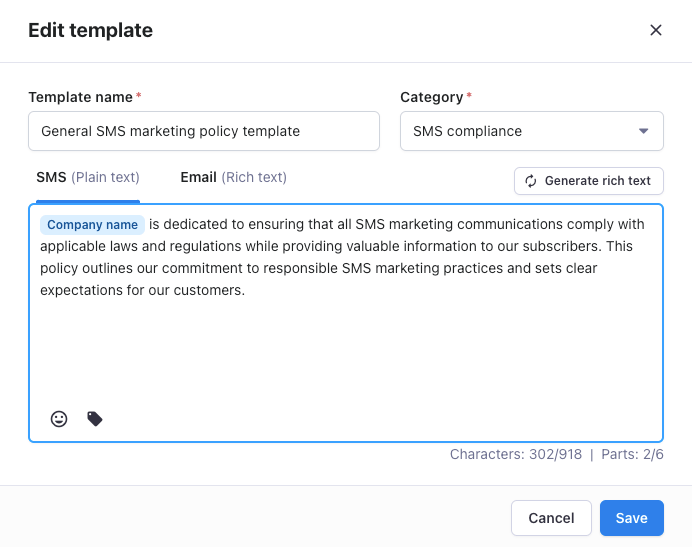
Are you struggling to navigate the complexities of SMS marketing compliance? With regulations like the Telephone Consumer Protection Act (TCPA) and the General Data Protection Regulation (GDPR) impacting your messaging efforts, how can you ensure that your practices align with legal requirements? SMS policy templates are crucial tools that can help businesses address these challenges.
Understanding their significance is essential for any organization looking to leverage SMS marketing successfully while adhering to legal standards. Dive into this article to learn how to protect your business and effectively engage your audience.
What are SMS policy templates?
SMS policy templates are structured documents that outline the rules and guidelines businesses must follow when conducting SMS marketing. They are essential for ensuring compliance with legal regulations, such as the TCPA in the United States, the Privacy Act 1988 in Australia, or the GDPR in Europe.
Implementing SMS policy templates helps businesses protect themselves from potential legal issues, enhances customer trust, and improves overall engagement by ensuring transparent communication practices.
Key features of SMS policy templates:
- Consent management: Templates specify how businesses should obtain explicit consent from customers before sending promotional messages.
- Opt-out procedures: They provide clear instructions for recipients on how to opt-out of receiving future messages, ensuring compliance with unsubscribe requirements.
- Message frequency: Templates often include guidelines on informing customers about the frequency of messages they can expect to receive.
- Data privacy: They address how customer data will be collected, stored, and protected, aligning with privacy regulations.
Types of SMS policy templates
SMS policy templates are essential for businesses aiming to ensure compliance with SMS marketing regulations while effectively engaging customers. Here are key types of SMS policy templates to consider:
1. General SMS marketing policy template
This template provides an overview of the principles guiding your SMS marketing practices. It includes guidelines for obtaining consent, managing customer data, and ensuring compliance with legal regulations.
When to use: When establishing a comprehensive framework for all SMS marketing practices. It is essential during the initial setup of your SMS marketing program and should be revisited regularly to ensure compliance with changing regulations and best practices.
2. Opt-in policy template
The opt-in policy template outlines how businesses should obtain explicit consent from customers before sending SMS messages. It details the methods for collecting consent, such as through sign-up forms on websites, mobile apps, or during customer interactions. This template ensures that customers are aware of what they are subscribing to and reinforces the importance of informed consent.
When to use: Use this template when you need to outline the procedures for obtaining consent from subscribers. It is particularly important during the onboarding process for new SMS campaigns, ensuring that you have clear and documented consent before sending marketing messages.
3. Opt-out policy template
An opt-out policy template specifies the process by which recipients can unsubscribe from SMS communications. It should clearly state the steps customers need to take to opt-out, such as replying with a specific keyword (e.g., “STOP”). This template is essential for compliance with regulations requiring easy and accessible opt-out options, helping maintain customer trust.
When to use: This template is necessary when you want to communicate the process for subscribers to unsubscribe from SMS messages. It should be included in all SMS communications and highlighted during the sign-up process, ensuring users know how to opt-out at any time.
4. SMS privacy policy template
This template addresses how businesses handle customer data in the context of SMS marketing. It covers aspects such as data collection, storage, protection measures, and usage of customer information, ensuring compliance with privacy laws like GDPR and CCPA.
When to use: Implement this template when you are addressing how customer data is collected, stored, and protected in the context of SMS communications. This policy is crucial during the development of your SMS marketing strategy and should be regularly updated to comply with data protection regulations.
5. Frequency and content policy template
This template outlines the expected frequency of text messaging communications and the types of content customers can anticipate. Clearly communicating this information helps manage customer expectations and reinforces transparency in communication.
When to use: When you want to inform subscribers about the expected frequency of SMS communications and the types of content they will receive. It is beneficial during the initial subscription phase.
*Notification letter template
In the event of a data incident, organizations must communicate transparently with affected individuals. A notification letter serves as an official communication to inform customers about the incident, the type of data involved, and the steps they can take to protect themselves.
This letter ties directly into your overall SMS policy framework, ensuring compliance and fostering trust with your subscribers. Below is a template that can be used for this purpose.
Best practices for creating SMS policy templates
Implementing these best practices will enhance trust and compliance in your SMS marketing efforts, ultimately leading to better engagement with your audience. Here’s what you need to keep in mind:
- Clarity and simplicity: Use clear, concise language to ensure that all subscribers understand the policies without confusion.
- Regular updates: Review and update your policies regularly to comply with changing regulations and to reflect any changes in your SMS marketing practices.
- Transparent consent: Clearly outline how you obtain consent, including what subscribers agree to receive when they opt-in.
- Easy opt-out: Make the opt-out process straightforward and accessible, allowing subscribers to easily unsubscribe from SMS communications.
- Data protection: Ensure that your policies include provisions for protecting subscriber data and maintaining privacy in compliance with applicable laws.
- Frequency transparency: Inform subscribers about the expected frequency of messages to manage their expectations and reduce unsubscribe rates.
- Feedback mechanism: Include a way for subscribers to provide feedback about their SMS experience, helping you improve future communications.
Tools and resources for SMS policy management
SMS marketing platforms
- Textmagic: we pride ourselves on being a leading SMS marketing platform that equips businesses with comprehensive tools to effectively manage their SMS campaigns. Our features include compliance management, consent tracking, and user-friendly opt-out processes, allowing us to engage with our audience while adhering to best practices.

- Other platforms: Additional platforms like Twilio offer robust APIs for SMS integration with built-in compliance features, while Bandwidth provides a flexible communication platform that supports SMS, allowing businesses to implement effective messaging solutions.
Legal resources
- Federal Communications Commission (FCC): The FCC outlines guidelines and regulations concerning SMS marketing in the United States, including the Telephone Consumer Protection Act. Their website is a valuable resource for understanding compliance requirements for SMS communications.
- Legal Information Institute (LII): The LII at Cornell Law School provides an overview of telecommunications laws, including regulations affecting SMS marketing.
- Privacy Rights Clearinghouse: This resource offers insights into data protection laws, privacy policies, and best practices for managing customer data in line with regulations like GDPR and CCPA.
with Textmagic!
Conclusion
By implementing these five essential SMS policy templates, your business can effectively manage consent, safeguard customer data, and avoid costly fines or reputational damage.
Remember, compliance is an ongoing process. Regularly review and update your policies to stay in line with evolving regulations and best practices. By prioritizing compliance, you not only protect your business but also enhance customer relationships by demonstrating a commitment to responsible and ethical communication practices.
Now is the time to integrate these templates into your operations, ensuring that your SMS campaigns are both effective and compliant.
Frequently Asked Questions (FAQs)
Having a clear SMS policy helps protect your business from legal risks, ensures consistent communication, and builds trust with your customers. It also keeps your team aligned on how and when messages should be sent.
Key components typically include opt-in and opt-out procedures, message frequency limits, content guidelines, compliance with laws like the TCPA or GDPR, and a plan for handling customer data securely.
Yes, in most countries, businesses must obtain explicit consent before sending marketing or transactional messages. This can be done through sign-up forms, checkboxes, or keyword-based opt-ins.
It’s a good idea to review your SMS policy at least once a year or whenever there are changes to messaging laws or business practices. Regular updates help ensure ongoing compliance and effectiveness.
Yes, starting with a policy template can save time and ensure you cover the essentials. However, it’s important to customize the template to reflect your specific business needs and legal obligations.
Related articles
Top 10 benefits of online texting services you haven’t considered
Texting is the pinnacle of convenience for instant c...
Text messaging laws your business should know
Many countries such as the US, the UK, Australia, an...
When texting emojis in your business communication is a good idea?
For many people, emojis have become a part of daily ...
What is number porting? Pros, cons, and business considerations
Are you considering switching mobile providers but a...
What is value-based selling and how it outperforms traditional sales strategies?
Traditional selling feels like a one-way street, whe...




